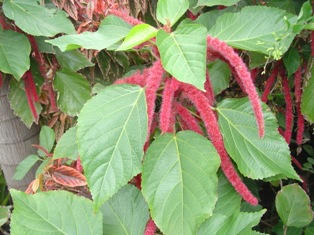Acalypha arvensis
(Acalypha means “not good to touch,” because it resembles a nettle. Arvensis means “of the field”)
Euphorbiaceae
Many gardeners know Copperleaf (Acalypha wilkesiana) and Chenille Plant as showy fast-growing idiot-proof landscape shrubs. They are just the horticultural tip of the iceberg among wild-growing less ostentatious Florida acalyphas, of which there are about nine species, most native. Today’s species is a originally South American, reportedly dating back in Florida to the 80s, cropping up sporadically around the state.

It has a puzzling and curious unexplained feature shared with some other Acalypha species: two different types of functional female flowers on separate parts of the flower stalk. Not counting some plants that make tiny hidden self-pollinated flowers, I can’t think of any other plants with two types of female flowers. For vocabulary buffs we’re talking about “allomorphic pistillate flowers.”
Let’s get the lay of the land on the flower spike. From bottom up: that leafy region is where most of the female flowers lie hidden among the little leaves (bracts). The skinny bumpy region above the leafy female zone is the male (pollen-producing) zone. The bumps are the male flowers. Now look at the tippy top. The weird green “thing” up there is a (or two) female flower(s) utterly different from those below.

But why? Searching the internet, I found an article or two describing the existence of the wacky top flowers, but crickets on what they are all about. They do make seeds.
You might ask, “why don’t more plants make two types of female flowers?” That way, if one type doesn’t get pollinated, maybe the other type will. You could go to an extreme…one type pollinated say by insect A in the morning and the other by insect B after lunch (or by the wind). I’m a little surprised, come to think of it, that that is not widespread. But not how Mother Nature usually rolls.

The bottom (among the leaves) female flowers are generally believed to be wind-pollinated. They look like it. So then do the nonconformist top-of-the-flagpole flowers somehow get pollinated differently, or at a different time, or under different circumstances? Nobody knows. Nobody cares except us chickens.
Although the top flowers are not showy or fragrant, something I noticed at home in a couple of my photos, hey, there’s an insect up there. Then a second one. Incidental? Or players? You decide. Here is some food for that thought: All that red in the flower stalk could have to do with insect attraction. To add to that utterly speculative notion, the decorative portion of the garden Chenille Plant (Acalypha hispida) is covered with nothing but reddish female flowers that have reverted from wind pollination to attracting insects. Is A. arvensis taking a baby step in that direction? I dunno.

Suellen
October 2, 2020 at 12:03 pm
Fascinating post, lots to think about. I also had no idea that there are native Florida Acalyphas.
George Rogers
October 2, 2020 at 12:57 pm
Hi Suellen….nice to hear from you! The natives are mostly weedy.
theshrubqueen
October 5, 2020 at 8:29 pm
To my horror, I like the weedies, this one is new to me, thought they were South Pacific plants.